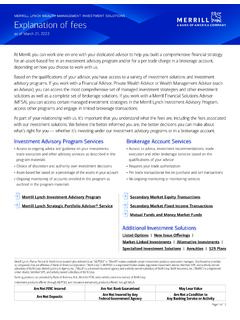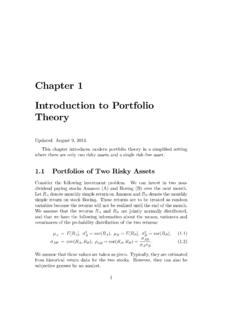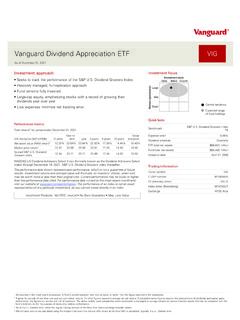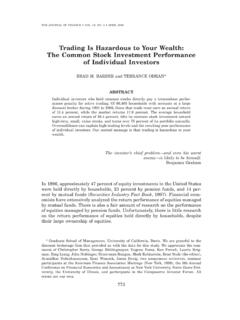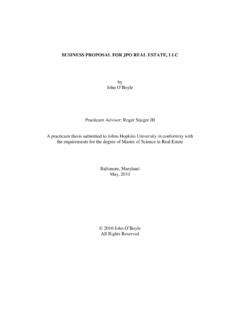Transcription of Collective Investment Trusts - ctfcoalition.com
1 Prepared by the Coalition of Collective Investment Trusts Collective Investment Trusts 2015 Coalition of Collective Investment Trusts 1 Table of Contents Overview .. 2 Collective Investment Trusts Defined .. 3 Two Broad Types of Collective Trusts .. 3 The Investment Option Selection Process .. 4 The Evolution of CITs .. 5 Features of CITs .. 9 Governing Documents .. 9 Regulatory Oversight of CITs .. 10 Federal and State Banking Laws .. 10 DOL .. 11 IRS .. 11 Federal Securities Laws .. 11 FINRA .. 12 CFTC .. 12 Growth in CITs .. 13 Conclusion .. 14 2015 Coalition of Collective Investment Trusts 2 Overview Collective Investment Trusts (CITs), also known as commingled funds, Collective Investment funds or Collective trust funds, are growing in number and assets.
2 Long a popular choice of defined benefit (DB) plans, in recent years CITs increasingly have become a choice of defined contribution (DC) plan sponsors. CITs continue to grow in popularity for a variety of reasons, including recordkeeper acceptance, consultant familiarity, pricing flexibility, daily valuation, National Securities Clearing Corporation (NSCC) Fund/SERV compatibility, and improved reporting and transparency as a result of compliance with Department of Labor (DOL) disclosure requirements under the Employee Retirement Income Security Act (ERISA). Plan sponsors also appreciate that CIT trustees are subject to ERISA fiduciary standards with respect to ERISA plan assets invested in CITs.
3 Formed in 2012, the Coalition of Collective Investment Trusts (CCIT) brings together Collective trust fund sponsors, money managers and related service providers active in the Collective trust fund industry. With approximately 40 member companies, the Coalition represents a sizeable portion of the rapidly growing Collective trust fund market, which includes $ trillion in assets as of December 31, 2013, according to Morningstar. For more information about the CCIT, visit The CCIT hopes this white paper provides those who invest in, research and recommend CITs a better understanding of how the funds operate, their structure and when they might be appropriate Investment vehicles for eligible retirement plans.
4 2015 Coalition of Collective Investment Trusts 3 Collective Investment Trusts Defined CITs in general are pooled Investment vehicles organized as Trusts and maintained by a bank or trust company. CITs are designed to facilitate Investment management by combining assets from eligible investors into a single Investment portfolio (or fund ) with a specific Investment strategy. By commingling, or pooling, assets, sponsors of CITs may take advantage of economies of scale to offer lower overall expenses, enhanced risk management, and more diverse and innovative Investment opportunities for the participating investors than such investors could achieve by investing these assets on their own.
5 Each fund is managed and operated in accordance with the applicable trust s governing documents, which generally include a declaration of trust (or plan document) and the fund s statement of characteristics. Two Broad Types of Collective Trusts Collective Trusts generally fall into two types: A1 funds (also referred to as common trust funds); and A2 funds (also referred to as Collective Investment funds or Collective Investment Trusts ). The terms A1 funds and A2 funds refer to the specific sections of the Office of the Comptroller of the Currency (OCC) regulations that established these two types of vehicles, as further described in the Regulatory Oversight section of this paper.
6 A1 funds involve the pooling of assets of various trust accounts held by a bank in its capacity as trustee, executor, administrator, or guardian. Participants in A1 funds do not have to be tax exempt entities (although tax exempt Trusts can participate in these funds). Common trust funds can qualify for tax exemption under Section 584 of the Internal Revenue Code of 1986 if they comply with IRS regulations. Typical investors (or grantors in a trust relationship) include foundations, corporations, endowments, Trusts and other entities that are exempt from federal income tax. Some A1 funds accept Investment from certain taxable investors, including high net worth individuals and asset aggregators.
7 A bank or trust company should be cognizant of the impact of accepting individuals and certain other types of investors under securities laws, tax laws and banking laws. In this white paper, the CCIT focuses on A2 funds and uses the term Collective Investment trust (CIT). Generally speaking, only certain retirement plans such as 401(k) plans, other defined contribution or defined benefit retirement plans that are qualified under Internal Revenue Code Section 401(a), and government 457(b) plans may invest in CITs. Under certain circumstances, CITs may permit Investment by qualified plans that include self employed persons (often referred to as HR 10 plans ) and church plans. Retirement plans qualified under Puerto Rico tax laws and covering only Puerto Rico residents may also invest in a CIT, in accordance with a series of IRS Revenue Rulings.
8 Generally, CITs may not hold assets of 403(b) plans, individual retirement accounts (IRAs), or health savings accounts. The rules governing who can invest in a CIT are contained in statutes, related regulations, and rulings under banking, securities and tax law. See the Regulatory Oversight section of this document for more information about the regulatory framework applicable to CITs. 2015 Coalition of Collective Investment Trusts 4 The Investment Option Selection Process Today, the retirement plan marketplace generally revolves around outcome oriented strategies designed to position participants for a comfortable retirement. As plan sponsors, intermediaries and other service providers consider Investment strategies, they will want to compare the available vehicles for a given approach.
9 Plan fiduciaries should make all decisions, particularly those concerning the plan s Investment menu, utilizing a prudent and well documented decision making process. Because Investment platforms offer several types of Investment vehicles for retirement plans, including mutual funds, CITs, separate accounts and annuities, it is both more difficult and more important than ever for plan fiduciaries to understand the various vehicles and make informed choices. Plan fiduciaries must evaluate many factors, including cost, to determine which options will best serve the plan s needs. For example, the provider s available Investment universe, the plan s own Investment policy statement (IPS), trading and operational considerations, current market trends, the demographic makeup of the plan s participants, and the current regulatory environment should all play roles in the fiduciary s decision making.
10 Given the many variables, no single option will necessarily provide the best fit for all the plan fiduciary s criteria. As with all decisions, plan fiduciaries should select Investment vehicles based on what is in the best interest of the plan participants and their beneficiaries. Each plan s unique situation will inform which Investment vehicles might be appropriate. Some of the key questions a plan fiduciary should consider when selecting an Investment vehicle for his or her plan s Investment lineup might include: Is the plan provider s current Investment universe appropriate? Is the cost structure appropriate given the plan size, services provided and the scope of desired Investment options?



